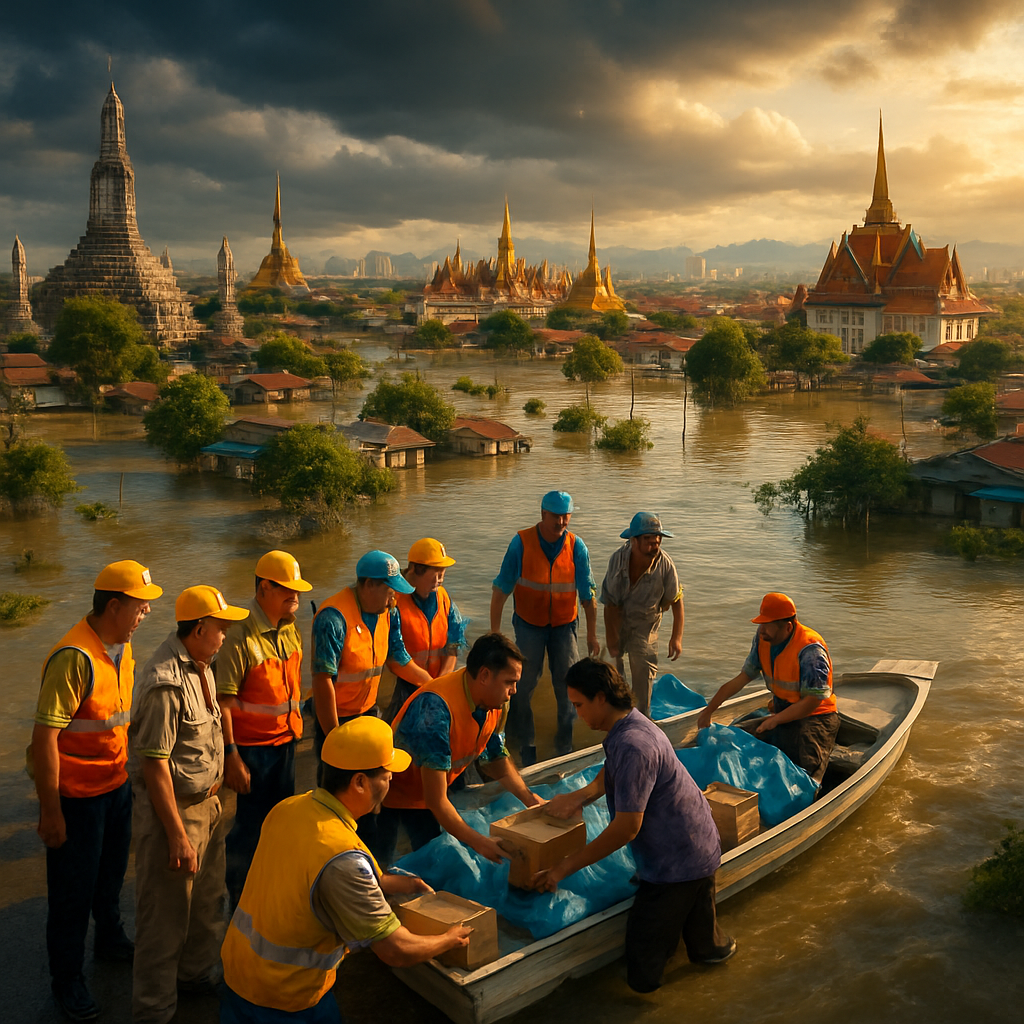In the heart of Thailand, amidst the vibrant chaos that is so characteristic of Southeast Asia, the provinces north of Bangkok are grappling with a deluge that has taken both residents and authorities on a wild, watery ride. Just last week, the governor of Pathumthani, Ekawit Meepien, was seen personally delivering consumer products to an 82-year-old blind woman marooned in the flooded tambon Ban Mai of Muang district. Such heartwarming efforts become everyday tales in Pathum Thani, which is just one of the nine drenched provinces in the Central Plains.
Good news, though, appears on the horizon as hydrologists predict a much-needed reprieve. From November 20 to 24, the mighty Chao Phraya River is forecast to recede by 40 to 75 centimeters. This is due to a strategic reduction in water discharge at the Chao Phraya barrage in Chai Nat province, a crucial move orchestrated by the vigilant deputy secretary-general of the Office of the National Water Resources, Mr. Paitoon Kengkanchang. With rainfall easing up in the northern regions, it will enable officials to decrease the powerful flow from a hefty 2,800 cubic meters per second to a manageable 2,400–2,700 cubic meters per second.
This downshift in rainfall and river release has also been echoed in the north at the Bhumibol dam in Tak province. The inflow reduction allows a discharge drop from a vast 50 million cubic meters per day on Sunday to a slightly less intimidating 45 million on Monday, significantly lowering the water level along the iconic Ping River stretching through Tak, Kamphaeng Phet, and Nakhon Sawan provinces by 10–15 centimeters.
But lest we celebrate prematurely, alerts remain in effect as the Royal Irrigation Department works tirelessly to divert portions of the Chao Phraya’s currents into nearby fields. Water levels south of the barrage will see a visible dip as operations proceed from November 20 through 24.
Despite forecasts, 13 provinces battle ongoing floods. In these Central Plains water-bound zones, Uthai Thani’s Muang district observes manageable waters, while Chai Nat’s districts of Wat Sing, Manorom, and Muang retain stable levels. There’s a sense of homeostasis in Sing Buri, where In Buri, Phrom Buri, and Muang districts sit poised amidst stagnant floods. Meanwhile, Ang Thong reveals a mix of relief and challenge as floods diminish in Pa Mok and Wiset Chai Chan yet hold their ground elsewhere.
The historical provinces of Ayutthaya and Nonthaburi, breathing with the essence of ancient Thailand, maintain a stoic front with stable levels through several districts. This same river pulse echoes in Nakhon Pathom where areas such as Bang Len and Sam Phran stand pat despite the threats from above.
Further north, Phitsanulok’s Bang Rakam district feels the river’s rising mood, a contrast to neighboring Sukhothai where water has begun its retreat. Across the northeast in Ubon Ratchathani, places like Muang and Warin Chamrap witness a gradual decline in water levels, a testament to the hardworking spirits of local communities rising above the elements once again.
As the monsoon’s curtain slowly falls, the collective sigh of relief may not yet be audible, but plans for rebuilding and restoring livelihoods are certainly taking shape. Through the ebb and flow of nature’s theater, Thailand, with its remarkable endurance and buoyant spirit, sails through, one wave at a time.


















It’s truly amazing how resilient Thailand is, but how many times do we have to see the same cycle of flood and relief efforts before more permanent solutions are implemented?
Permanent solutions like what? Building a giant sea wall? The geography makes it almost impossible.
Not a sea wall, maybe better infrastructure for drainage and flood management? Other countries have done it.
I don’t understand why they don’t just relocate the people living in the most flood-prone areas! It’s a disaster waiting to happen.
Relocation is not that simple. There’s culture, history, and livelihood tied to these places. We can’t just uproot people.
But isn’t their safety more important than culture? I’d rather be dry than preserve history in a flood.
I hope the government heeds the warning signs this time. Climate change is only going to make these events more frequent.
Government does what it can, but citizens need to play their part too. We need to push for more green policies.
True, but recent administrations haven’t prioritized climate action as much as they should have. It’s frustrating!
The way the community comes together during these times is inspiring. Shows the true spirit of Thailand.
It’s heartwarming but should charity be the backbone of our disaster management? We need better systems in place.
Nature always wins. We are just temporary visitors on this planet. Adapt or perish.
A bit nihilistic, don’t you think? With science and technology, we can coexist with nature rather than surrender to it.
Maybe, but look around, every civilization falls eventually when they ignore nature.
Ignoring isn’t the same as coexisting, though.
Why don’t international bodies do more in assisting with these crises? It’s a global responsibility!
Countries can’t just swoop in without invitation. It’s not that simple due to sovereignty and politics.
Fair point, but surely more pressure can be applied diplomatically?
Why aren’t we talking more about how these irrigation practices could impact local ecosystems negatively?
This whole flooding situation is mismanagement at its finest. These regions flood like clockwork and everyone seems unprepared.
Traditional rainwater harvesting could be a solution but nobody seems interested in old methods.
With the government focusing on flood control, I hope it doesn’t forget about other pressing issues, like education and healthcare.
Every country’s got multiple crises to manage, but when your house is flooding, patching that is urgent.
The Bhumibol dam regulation is a good step, but it hasn’t been consistently effective in the past.
If every monsoon brings this much chaos, imagine a few decades down the line. Time to innovate, not mitigate.
The constant focus on building infrastructure rather than sustainable solutions is missing the point of long-term climate resilience.
Predicting floods isn’t enough if the infrastructure to deal with them isn’t in place.
Yes! Alerts are great, but without action, they don’t mean much.
Can someone explain how reducing the water discharge upstream actually helps downstream areas?
It’s about slowing down water paths to prevent overflow at choke points. However, the timing and coordination must be precise.
Makes sense, but it seems too scientific for timely responses. Doesn’t sound easy to implement.